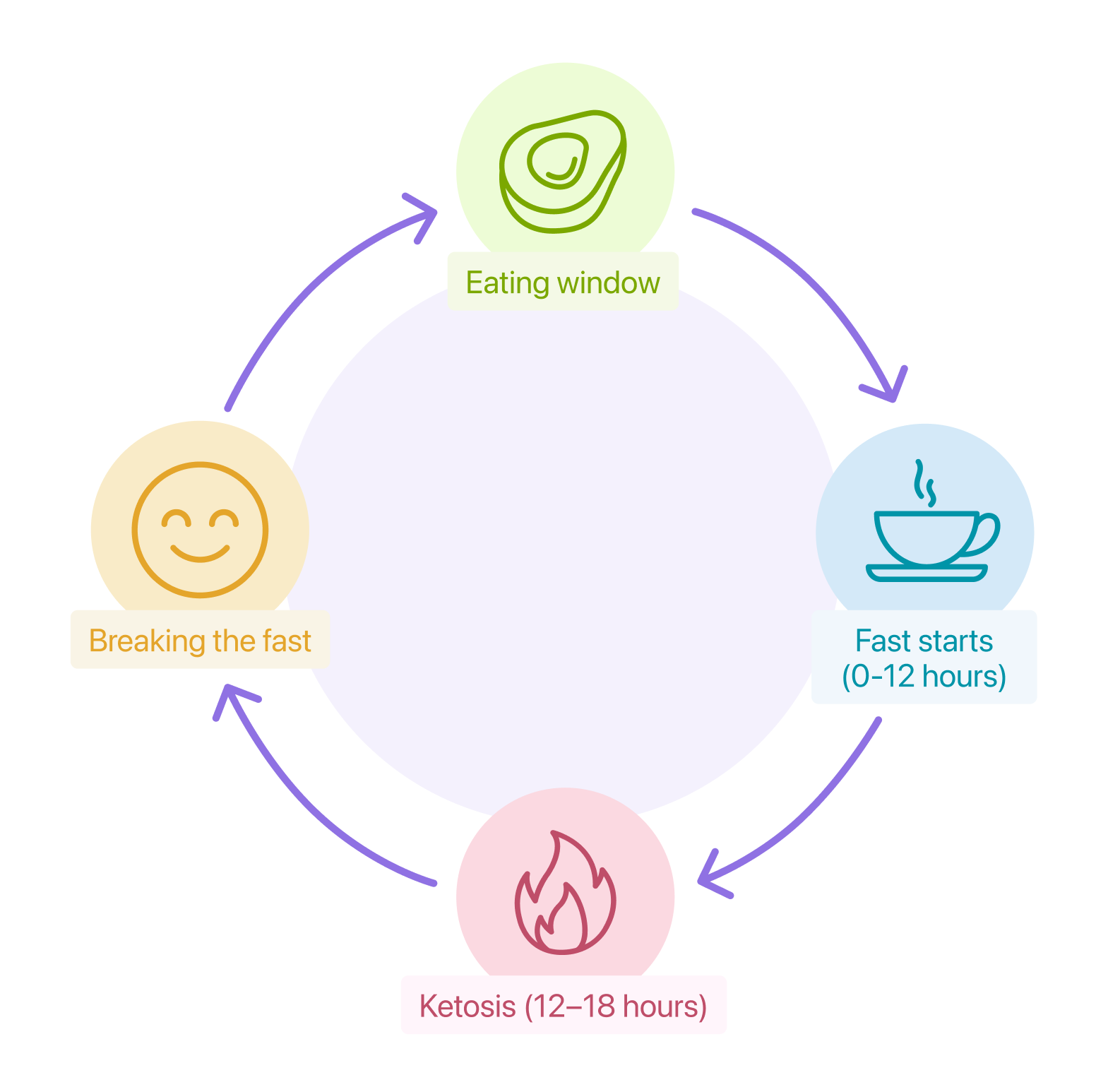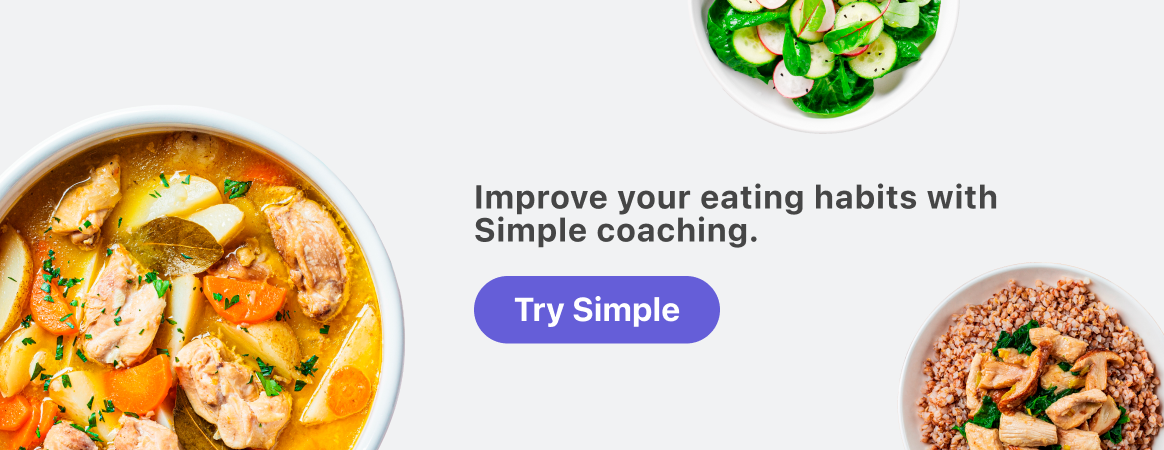The 4 stages of intermittent fasting — a guide by Simple

If you’re trying out intermittent fasting in the hope that it’ll yield a positive result in your body, you may be curious about what’s going on under the hood.

What happens in your body during the various stages of intermittent fasting? Why does it make positive things happen for your health, like improved blood pressure, lower cholesterol, and a leaner physique?
This isn’t just random or nice-to-know information. If you understand what’s really going on in your body, you can take action to optimize your results. Let’s get clear on the mechanics at work here, so you can get your intermittent fasting engine running smoothly.
If you’re new to all this, first check out our intermittent fasting for beginners article to get your bearings.
The stages of intermittent fasting — a timeline

If you’d prefer to see the intermittent fasting stages in a visual format, check out our table here!
Stage 1: Your eating window (pre-fast)
How you feel throughout your fasting window — and how quickly your body responds to your fast — depends, at least in some part, on what you eat and drink beforehand.
If you eat lots of foods that are high in refined carbohydrates and low in protein, fiber, and fat, you’ll likely experience more hunger, your cravings will be harder to manage, and you’ll probably feel sluggish and tired.
Plus, it’ll take longer for your body to use up the glucose in your bloodstream, and this has a domino effect on how the following fasting timeline plays out.
Stage 2: 0–12 hours into your fast (insulin’s rise and fall)
During the first four hours after your meal, your body is using everything you just ate to fuel your activities, power your body’s processes, and top up your glycogen levels. You’ll stay in this stage until the energy from the food you ate is used up.
This stage is where your insulin levels are highest.[1] Insulin is released if your recent meal contained carbs and/or protein, and it gets busy shuttling glucose from your bloodstream to be stored in your liver and fat cells as glycogen. Somewhere between 4 and 8 hours after your meal, insulin finishes its work, and your blood sugar levels start to normalize.
If we consider the stages of fasting by the hour, you might notice, around 8 hours in, that:
- you start to feel hungry, tired, and irritable
- it’s harder to concentrate
- cravings are kicking in
This tells you that your blood sugar has dropped significantly, your leptin (a hormone that signals fullness) is falling, and your ghrelin (a hormone that signals hunger) is rising.
Over the next four hours, between 8 and 12 hours after your meal, your body starts to use up your stored glucose (glycogen). Then, when you’ve run out of glycogen, your body flips its metabolic switch to start using another fuel source — your stored body fat.[1]

Stage 3: 12–18 hours into your fast (ketosis)
Somewhere in the 12–18 hour range after you start fasting, your body will start ketosis (the exact timeline varies from person to person, but this is the general ballpark).[2]
Now your activities are fueled — not by the calories you’ve eaten or glycogen you’ve stored — but by the fat you’ve got in your body. This is one of the essential phases of fasting to hit if you’re fasting to lose weight.
Again, the meals you ate during your eating window will have an impact here, particularly on how long it takes for you to reach this stage. If you ate mainly carbohydrate-based foods, it’ll take longer to lower your blood sugar levels and get into ketosis than if you ate more protein and fat.
As we saw in stage 2, some stages of fasting signal themselves via bodily symptoms you can observe. One of ketosis’ “tells” is that you don’t feel hungry because appetite suppression is an effect of ketones (the fuel source produced by the liver from stored fatty acids during ketosis).
Stage 4: 18+ hours (breaking the fast)
At Simple, we are big fans of these TRE (time-restricted eating) intermittent fasting schedules:
These are the schedules we consider both safe and effective. That’s why our breaking-the-fast stage arrives no later than 18 hours into the process.
At this stage, in order for you to get sufficient nutrients and calories into your diet over the long term, we recommend you open your eating window and get into your next meal. (Unless you have the all-clear from your doctor to fast beyond 18 hours.)
What should that meal be? Read on!
P.S. If you’re eager to learn how to start intermittent fasting and try out a TRE fasting schedule yourself, we can hook you up! Take our Simple quiz to get started and use our fasting and food trackers — plus our extensive library of fantastic in-app articles — to get super savvy on taking care of your health and well-being.
How should you break your fast?

Let’s drop some detail on how to nail stage 4 — breaking your fast.
From experience, we know this can be one of the most enjoyable fasting stages (especially if you’re doing 18:6 intermittent fasting and it’s been a looong day already).
What breaks a fast is any calorie-containing food or drink, but if you can be a bit more strategic here, you’ll feel mentally sharper and have more energy during the hours ahead.
So, what’s the best way to break your fast? Well, as always, it’ll be somewhat unique to you. However, we do have some guidelines to help.
Choose foods that give you energy
When you’re intermittent fasting, your food choices matter even more because you’re restricting your food intake to a compressed time frame. If you’re eating less — as will naturally happen when you fast for 12–18 hours — getting enough high-quality nutrition has to happen in fewer foods.
So, choose foods that:
- maximize your energy and the amount of nutrients you’re getting in every bite
- minimize your hunger and cravings
In practice, that means combining lean protein, veggies and/or fruit, whole grain carbohydrates, healthy fats, and calcium-rich foods as best you can.
Ultra-processed foods and foods high in refined carbohydrates may seem really appealing after a fast. Try to choose these options less frequently, as they’ll spike your insulin levels, creating a short-term blood sugar crash. Longer-term, they can be more health-depleting than promoting.
This guide on what to eat during intermittent fasting will give you a more in-depth steer on the kinds of foods that punch above their weight in both stage 1 and stage 4 fasting phases.
Choose foods you like
You need to eat every day. Even if you’re an 18:6er and only have 6 hours to do it, you still gotta eat.
So, if you can, enjoy your food.
There is literally no point in eating foods you hate in the name of health. Either because:
- you won’t eat it often enough to get the benefit, or
- it makes your life suck (and life is hard enough already!).
To get the best of both worlds — super tasty food and life-enhancing health — find ways to love the foods that love you back.
You might need to add a few culinary skills to your repertoire and spend a bit more time learning to feel at home in the kitchen, but healthy food can taste amazing.
Can you exercise during your fast?
Exercise and intermittent fasting are a real power couple. They go great together because exercise straps a rocket pack to the health benefits of intermittent fasting by helping you:
- lose weight
- have more energy
- improve your blood pressure
- regulate your blood sugar levels better
- reduce your risk of chronic diseases
- preserve muscle mass [3]
- ensure that intermittent fasting does not slow your metabolism
- lower your cholesterol levels
For best results, you may prefer to exercise during stages 1 and 4 when you’re fed. Or, you may prefer to exercise when you’re fasted during stages 2 or 3. The science is easy either way — both can work well.[4]
Which one works for you depends on two things:
- How you feel during your exercise session. Which gives you more energy — being fed or being fasted?
- Where your workout fits into your day. If it’s 6 AM or bust, but you don’t break your fast till 10 AM, you may have to train fasted and adapt your workout to suit. Or you can shift your fasting window.
There are no rules here except figuring out the best approach for you.
Same with which kind of exercise you do. You can lift weights, swim, run, or ride a bike. You can do yoga, tai chi on a windy hillside, or jump rope like a boxer. You can do pilates at your local Y, hike in the hills, or play pickleball.
If you’re stuck for ideas on how to integrate exercise into your fasting routine, get some extra help from our full guide on intermittent fasting and working out.
How to practice intermittent fasting safely

Is fasting good for you? Yes, it can be. But, like anything, you gotta practice it safely and look after yourself to really get the most from it. Here are some ways you can do that.
Start slow
There is no rush to try a longer fast. Yes, the research says it can be effective for weight loss and health,[5] but experience tells us that starting with shorter fasts and building up your fasting hours is a smart way forward.
Shoot for a 12- or 14-hour fast to start with, get good at that, then push your way up to 16- and 18-hour fasts (if you want to. It’s not mandatory!).
Eat well
As we’ve talked about, eating high-quality, nutrient-rich food is super important when fasting, especially if you’re doing longer fasts.
As much as you can, seek to make choices that help you feel, think, and perform your best. Shoot for plenty of:
- protein
- veggies
- fruit
- whole grain carbs
- healthy fats
- calcium-rich foods
Drink lots of water
Staying hydrated is also crucial. If you’re eating less, you’re naturally getting less fluids (because food contains water). To balance that out, and ensure you don’t run the risk of dehydration, drink plenty of water.
If you’re not a fan of plain water, check out our guide to that age-old question, “What can you drink while fasting?” to get some fresh ideas.
Listen to your body
Whenever you’re trying something new in nutrition land, tune into your body to get real-time feedback on how it’s going.
You’ll notice that intermittent fasting comes with some side effects, like feeling hungrier and crankier than usual. Don’t worry about these — they’re normal. They should pass in a couple of weeks, but if they don’t, go talk to your doctor.
As you continue practicing intermittent fasting, keep track of the following:
- what gives you energy;
- which foods feed your body, mind, and soul best; and
- which fasting schedule most suits your life.
Get some support from your family and friends
Social support has an intensely positive impact on our health. So, if you get stuck, ask for help. If you need someone to cheer you on, get them involved. If you need company on the journey, see who’s willing to join you.
We most definitely are! Take our Simple quiz, and we’ll be in your corner (well, in your pocket, really) pronto, with everything you need to help you squeeze all the goodness from each of the stages of intermittent fasting, day by day.

Who should avoid intermittent fasting?
Is intermittent fasting safe? Yes, for most people, but it’s not for everyone.
Leave intermittent fasting well alone unless your doctor signs off on it if you:
- are extremely active
- are under the age of 18, or 80 years old or more
- have a medical condition
- take prescription medications
- have a Body Mass Index (BMI) < 18.5
- are pregnant, breastfeeding, or trying to conceive
- have (or are at risk of having) an eating disorder, or have a history of one
The 5 stages of autophagy are initiation, elongation, maturation, fusion, and degradation. You might wonder why autophagy doesn’t figure as one of our stages of intermittent fasting. Well, it’s because much of the research on how fasting stimulates autophagy was done on animals,[6] and we don’t feel that’s strong enough to infer benefits to humans.
Yes, 17-hour intermittent fasting is effective — or it can be at least. The science is strong for the health and weight loss benefits of longer fasts, though the evidence is limited that fasting beyond 18 hours brings any extra benefits. Try it out for yourself if you’re curious (and it’s safe for you to do so).
It’s not 100% guaranteed, but if you want to know when your body is in fat-burning mode, there are a couple of ways to do that. You can do it by following the fasting timeline — when you’re 12–18 hours into your fast, the odds are you’re in ketosis. Or, you can pay attention to when your hunger drops and energy kicks in during that 12–18 hour window.
No, the opposite, actually. Hunger doesn’t mean you’re burning fat, but a lack of hunger (when fasting) might.
Check out our article “Does fasting lower blood pressure?” to find out all the details!

- Anton SD, Moehl K, Donahoo WT, Marosi K, Lee SA, Mainous AG 3rd, et al. Flipping the Metabolic Switch: Understanding and Applying the Health Benefits of Fasting. Obesity . 2018 Feb;26(2):254–68.
- Kolb H, Kempf K, Röhling M, Lenzen-Schulte M, Schloot NC, Martin S. Ketone bodies: from enemy to friend and guardian angel. BMC Med. 2021 Dec 9;19(1):313.
- Bhutani S, Varady KA, Klempel MC, Kroeger CM. Alternate day fasting combined with exercise: An effective treatment for weight loss and cardio‐protection in obese humans. FASEB J [Internet]. 2012 Apr;26(S1).
- Ashtary-Larky D, Bagheri R, Tinsley GM, Asbaghi O, Paoli A, Moro T. Effects of intermittent fasting combined with resistance training on body composition: a systematic review and meta-analysis. Physiol Behav. 2021 Aug 1;237:113453.
- Welton S, Minty R, O’Driscoll T, Willms H, Poirier D, Madden S, et al. Intermittent fasting and weight loss: Systematic review. Can Fam Physician. 2020 Feb;66(2):117–25.
- Chung KW, Chung HY. The Effects of Calorie Restriction on Autophagy: Role on Aging Intervention. Nutrients [Internet]. 2019 Dec 2;11(12).
